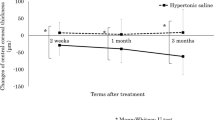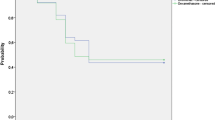Abstract
Purpose
To evaluate and compare the change in postoperative central macular thickness in patients receiving benzalkonium chloride (BKC)-preserved and BKC-free medications after uneventful phacoemulsification.
Setting
V.M.M.C & Safdarjung Hospital, New Delhi (a tertiary health care hospital).
Study design
Prospective randomized comparative observational study.
Materials and methods
Once patients were selected, the baseline standard ophthalmic examination was done. Sample size: 140 eyes were enrolled and randomly divided into two groups. (a) Group I: receive BKC-preserved topical medications and (b) Group II: receive BKC-free topical medications of same constituents postoperatively. Group I patients received topical BKC-preserved moxifloxacin 0.5% + dexamethasone 0.1% eye drops six times a day, timolol maleate 0.5% twice daily, tropicamide 0.8% + phenylephrine 5% once a day for 6 weeks, and Group II received same BKC-free topical eye drops for 6 weeks. Postoperatively, the patients were reviewed at day 1, week 1, week 6 for same parameters.
Statistics
Quantitative variables: paired and unpaired t test. p value < 0.05 was considered statistically significant.
Results
The mean CMT in μm at 1 week in Group I was 269.39 ± 14.56 and in Group II was 270.04 ± 6.56. The mean CMT in µm at 6 weeks in Group I was 270.39 ± 17.18 and in Group II was 270.90 ± 7.00.
Conclusion
Neither do BKC-preserved topical medications have any independent role in increasing the central macular thickness after uneventful surgery nor do they have any role in causing pseudophakic CME.



Similar content being viewed by others

References
Irvine S (1953) A newly defined vitreous syndrome following cataract surgery. Am J Ophthalmol 36:599–619
Gass JDM, Norton EWD (1966) Fluorescein studies of patients with macular edema and papilloedema following cataract extraction. Trans Am Ophthalmol Soc 64:232–249
Yonekawa Y, Kim I (2012) Pseudophakic cystoid macular edema. Curr Opin Ophthalmol 23:26–32
Miyake K, Ibaraki N, Goto Y, Oogiya S, Ishigaki J, Ota I et al (2003) ESCRS Binkhorst lecture 2002. J Cataract Refract Surg 29:1800–1810
Freeman P, Kahook M (2009) Preservatives in topical ophthalmic medications: historical and clinical perspectives. Expert Rev Ophthalmol 4:59–64
Pisella P, Fillacier K, Elena P, Debbasch C, Baudouin C (2000) Comparison of the effects of preserved and unpreserved formulations of timolol on the ocular surface of albino rabbits. Ophthalmic Res 32:3–8
Grant W (1974) Toxicology of the eye. Thomas, Springfield
Baudouin C, de Lunardo C (1998) Short term comparative study of topical 2% carteolol with and without benzalkonium chloride in healthy volunteers. Br J Ophthalmol 82:39–42
De Saint Jean M, Debbasch C, Brignole F, Rat P, Warnet J, Baudouin C (2000) Toxicity of preserved and unpreserved antiglaucoma topical drugs in an in vitro model of conjunctival cells. Curr Eye Res 20:85–94
Hee MR, Puliafito CA, Wong C et al (1995) Quantitative assessment of macular edema with optical coherence tomography. Arch Ophthalmol 113:1019–1029
Hudes GR, Li WY, Rockey JH, White P (1988) Prostacyclin is the major prostaglandin synthesized by bovine retinal capillary pericytes in culture. Invest Ophthalmol Vis Sci 29:1511–1516
Flach AJ (1998) The incidence, pathogenesis and treatment of cystoid macular edema following cataract surgery. Trans Am Ophthalmol Soc 96:557–634
Tsilimbaris MK, Tsika C, Diakonis V, Karavitaki A, Pallikaris I (2013) Macular edema and cataract surgery, in cataract surgery. In: Zaid F (ed) Cataract surgery. InTech. ISBN 978-953-51-0975-4
Von Jagow B, Ohrloff C, Kohnen T (2007) Macular thickness after uneventful cataract surgery determined by optical coherence tomography. Graefes Arch Clin Exp Ophthalmol 245(12):1765–1771
Sahin M, Cingu AK, Gozum N (2013) Evaluation of cystoid macular edema using optical coherence tomography and fundus autofluorescence after uncomplicated phacoemulsification surgery. J Ophthalmol 2013:376013
Akcay BI, Bozkurt TK, Guney E et al (2012) Quantitative analysis of macular thickness following uneventful and complicated cataract surgery. Clin Ophthalmol 6:1507–1511
Perente I, Utine CA, Ozturker C et al (2007) Evaluation of macular changes after uncomplicated phacoemulsifivcation surgery by optical coherence tomography. Curr Eye Res 32:241–247
Cagini C, Fiore T, Iaccheri B, Piccinelli F, Ricci M, Fruttini D (2009) Macular thickness measured by optical coherence tomography in a healthy population before and after uncomplicated cataract phacoemulsification surgery. Curr Eye Res 34:1036–1041
Sourdille P, Santiago P (1999) Optical coherence tomography of macular thickness after cataract surgery. J Cataract Refract Surg 25:256–261
Yoo J, Kim S, Lee S, Lee S (2012) Changes in macular thickness after cataract surgery according to optical coherence tomography. J Korean Ophthalmol Soc 53:246
Wang K, Cheng C (2014) Central retinal thickness changes and visual outcomes following uncomplicated small-incision phacoemulsification cataract surgery in diabetic without retinopathy patients and nondiabetic patients. Taiwan J Ophthalmol 4:33–39
Moreira Neto C, Moreira Júnior C, Moreira A (2015) Optical coherence tomography in patients undergoing cataract surgery. Arq Bras Oftalmol 78:241–245
Hwang H, Ahn Y, Lee H, Kim M, Kim E (2015) Comparison of macular thickness and inflammatory cytokine levels after microincision versus small incision coaxial cataract surgery. Acta Ophthalmol 94:189–194
Arora S (2012) OCT provides insights into retinal changes after uneventful cataract surgery. Ocul Surg News. Retrieved from https://www.healio.com/ophthalmology/retina-vitreous/news/print/ocular-surgery-news-europe-edition/%7B57b2f345-acb4-4f48-88bb-18f613f3f0dd%7D/oct-provides-insights-into-retinal-changes-after-uneventful-cataract-surgery
Puliafito CA, Hee MR, Lin CP et al (1995) Imaging of macular diseases with optical coherence tomography. Ophthalmology 102:217–229
Stein DM, Ishikawa H, Hariprasad R et al (2006) A new quality assessment parameter for optical coherence tomography. Br J Ophthalmol 90:186–190
Van Velthoven ME, Faber DJ, Verbraak FD et al (2007) Recent developments in optical coherence tomography for imaging the retina. Prog Retin Eye Res 26:57–77
Hee MR, Puliafito CA, Duker JS et al (1998) Topography of diabetic macular edema with optical coherence tomography. Ophthalmology 105:360–370
Miyake K (2001) Enhanced disruption of the blood-aqueous barrier and the incidence of angiographic cystoid macular edema by topical timolol and its preservative in early postoperative pseudophakia. Arch Ophthalmol 119:387
Abe R, Zacchia R, Santana P, Costa V (2014) Effects of benzalkonium chloride on the blood-aqueous and blood-retinal barriers of pseudophakic eyes. J Ocul Pharmacol Ther 30:413–418
Chhabra H, Gupta A, Singh G (2017) A comparative study of benzalkonium chloride-free latanoprost versus benzalkonium chloride-preserved latanoprost on ocular surface health in patients of primary open angle glaucoma. Int J Basic Clin Pharmacol 6:1110
Author information
Authors and Affiliations
Corresponding author
Ethics declarations
Conflict of interest
The authors declare that they have no competing interests.
Ethical approval
This article does not contain any studies with animals performed by any of the authors. All procedures performed in studies involving human participants were in accordance with the ethical standards of the institutional and/or national research committee and with the 1964 Helsinki Declaration and its later amendments or comparable ethical standards.
Informed consent
Informed consent was obtained from all individual participants included in the study.
Rights and permissions
About this article
Cite this article
Sethi, H.S., Das, S., Naik, M.P. et al. BKC and CME: Is benzalkonium chloride hindering our efforts to achieve the desired postoperative visual acuity?. Int Ophthalmol 39, 2129–2136 (2019). https://doi.org/10.1007/s10792-018-1051-7
Received:
Accepted:
Published:
Issue Date:
DOI: https://doi.org/10.1007/s10792-018-1051-7



